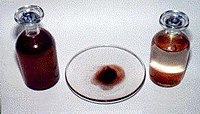
Photo from wikipedia
Aim The aim of the study was to detect the level of comprehensive diabetes control among the diabetic patients of Kerala, India. Methods Patients (1200) were randomly selected from a… Click to show full abstract
Aim The aim of the study was to detect the level of comprehensive diabetes control among the diabetic patients of Kerala, India. Methods Patients (1200) were randomly selected from a diabetes care center. Their blood sugar, biochemical and anthropometric measurements were done and statistically analyzed. Results Only 28.3% had their HbA1c at or below 7% and 45% above 9%. One-third of the female and one-fifth of the male patients had coronary artery disease. The prevalence of hypertension was almost equal in both sexes. However, there was a statistically significant higher systolic blood pressure (mean 162.12 mmHg vs 147.49 mmHg, p = 0.01044) among females. The total cholesterol was above 200 mg/dl in 42.1% of males and 45.61% of females. The triglyceride was >150 mg/dl in 38.6% males and 50.88% females. Low high density lipoprotein (HDL) cholesterol levels were found in 20.07% of males and 41.12% of females (p = 0.0445). The mean low density lipoprotein (LDL) was 121.75 (± 32.29) Conclusion The mean blood sugar values are found to be high, which will lead to a predictable increase in vascular disease, which in turn will affect the quality of health and productivity of the individual and the economic growth of the society as a whole. Studies suggest that therapeutic interventions to improve glycemic control may reduce the risk of cardiovascular disease and microvascular disease. This study shows that the level of diabetes control in Kerala is unsatisfactory. We need more medications, better strategies and more emphasis on glycemic management than we are currently able to apply.
Journal Title: Indian Heart Journal
Year Published: 2018
Link to full text (if available)
Share on Social Media: Sign Up to like & get
recommendations!